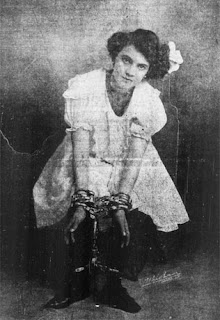Thelma Griffith

Houdini once complained about the “horde of imitators” performing on stages across the country. He had popularized the handcuff and challenge escape act, and audiences clamored to see such a performance. Houdini only played big-time vaudeville circuits and was also out of the country for many years touring Europe and Australia. Numerous performers emerged to fill this void and spent their careers playing small-time vaudeville. One example was the husband and wife team of Fred and Thelma Griffith. Nothing is known about Thelma’s background. This may not even be her real name. In a fanciful interview, she said that she was a native of Ostra-Toten (sic), Norway. Her father, of course, had been a locksmith. Fred was the stage name of Frank M Griffith. He was born in Green River, Wyoming around 1883. He started working in sideshows as a ticket seller and talker and was with the John Robinson Shows in 1899. By 1904 he was touring small-time vaudeville as a comedy magician. How Fred a...





